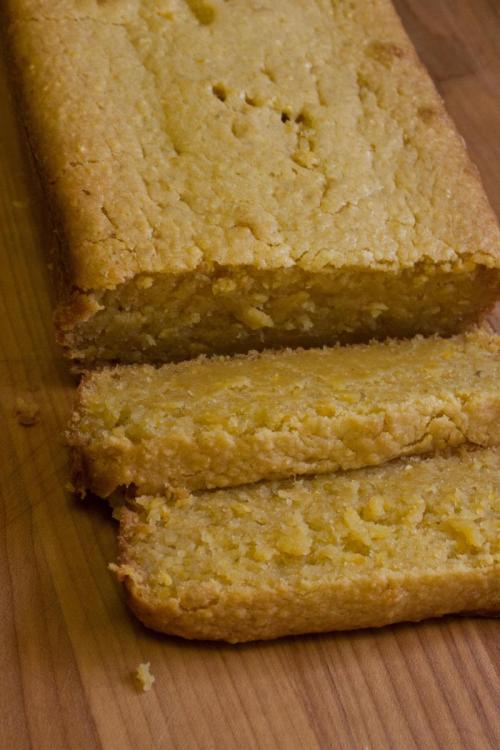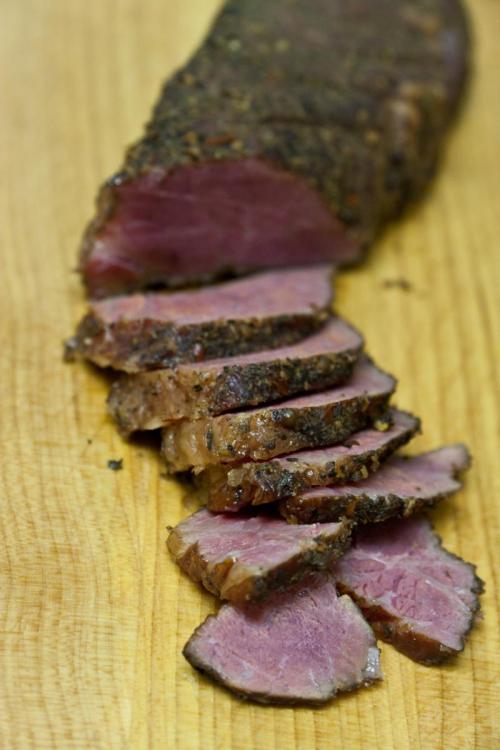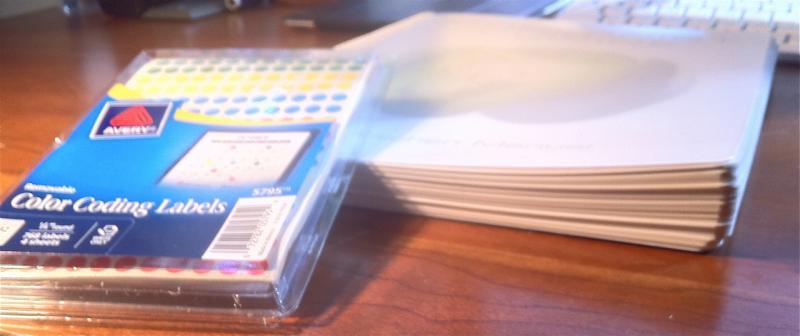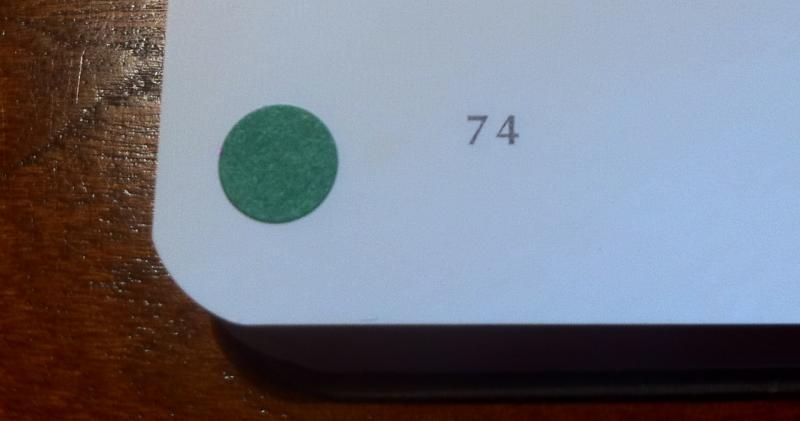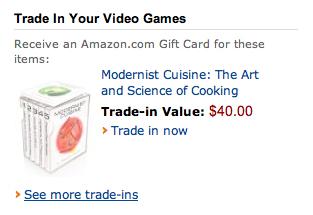
Borgstrom
participating member-
Posts
130 -
Joined
Content Type
Profiles
Forums
Store
Help Articles
Everything posted by Borgstrom
-
"Modernist Cuisine" by Myhrvold, Young & Bilet (Part 3)
Borgstrom replied to a topic in Cookbooks & References
I finally started volume 4 of Modernist Cuisine, which begins with a discussion of thickeners and viscosity. They mention non-Newtonian fluids but only give an example of shear-thinning fluids like ketchup, or fluid gels which act like solids until you stir them after which they act like liquids. Curiously, what doesn't seem to get mentioned is my favorite non-Newtonian fluid, the classic oobleck -- a mixture of corn starch and water. Oobleck is a shear-thickening fluid meaning it behaves like a liquid when you stir it slowly, but then seizes up and behaves like a solid when you stir quickly. If you didn't play with this when you were in school (or when your kids where in school) you really have to try -- it's fun and amazing! Anyway, this all got me to thinking about if there are any culinary applications for oobleck or other shear-thickening, non-Newtonian liquids. Wikipedia mentions two -- uncooked imitation custard and chilled caramel ice cream topping. But for modernist chefs growing bored of spherification, foams and liquid nitrogen, perhaps this could be a new avenue of exploration? Could you imagine a sauce that would behave like any other sauce on the plate, but then turn solid as soon as you bite down on it? Or a sphereified ball of the liquid which is hard when you bite it, but then collapsing into a liquid in your mouth once you release pressure. Talk about a surprise! -
Recent favorites: Incanto: Great flavors and unusual dishes using the whole animal. Highly recommended for a memorable dinner with great food and comfortable atmosphere. Chef Chris Cosentino (also owner of Boccalone) is very active/visible in the open kitchen (at least when I was there). Zero Zero: I've only been there for lunch, but the Neapolitan style pizzas are great, appetizers awesome (esp. daily seafood crudo), and the cocktail selection impressive. Flour+Water is supposed to be very good as well, but I've never been able to get in! For coffee drinks, head to Blue Bottle Coffee, either in Hayes Valley or the Ferry Building. Best esspresso drinks I've ever had, from their souped-up PID-controlled La Marzoccos and excellent baristas. Rituale is also very good. Another classic SF, hole-in-the-wall dive that I just love is Swan Oyster Depot. Normally I stay far away from SF tourist attractions, but I make an exception here. Open for lunch only (until 5pm) and no credit cards; expect to wait 45 minutes on the sidewalk to get one of their 10 or so stools at the counter. But once you get a seat, it is worth it. Oysters, clams, shrimp, fish, crab all prepared before your eyes by the 4-5 staff behind the counter. Oh, and the best clam chowder I ever had. Last time I went, they had fresh sea urchin. For something like $10, the guy took one of the live sea urchins, cracked it open, extracted the 5 "tongues" of roe out, cleaned out the top of the shell to use as a tray, and served to me on a bed of crushed ice. Probably the best, freshest uni I ever had. The decor, stools and staff probably hasn't changed in 50 years, but the with fresh seafood like that they don't need to. One more favorite: For authentic German fare, head to Suppenkuche. Walk through the doors, and it feels like you are in Munich. Very authentic, tasty food and excellent beer. Lots of others on my wish list, but I've had great success at these over the past few months.
-
I made the Cornbread (5-76) this weekend, following the updated advice Maxime gave. Even with this approach, the temperature didn't get up to 88C in 20 minutes. I made 150% scaling based on the corn I had, and split into two loaves. I took the first one out at about 25 minutes. Parts of it read 88C with my thermapen, but the top was still pale yellow and the center was jiggly and obviously under-done. I left the 2nd one in until a wooden skewer came out clean from the center (I know, very old-school) -- about 30 minutes more. The 2nd one (with a total of 55min at 130C) came out more golden-brown on top and pretty well-cooked all the way through, but perhaps still a bit too moist. I think the key point here is the size of the mold/pan you use. The photo in MC shows molds that appear to be about 7cmx14cm, whereas I used loaf pans that are about 11cmx22cm. MC's maxim on diffusion must come into play here -- double the thickness of something and it takes four times longer. The bigger the loaf pan, the longer it will take the heat to penetrate and the moisture to escape. I'm sure the 20 minute guideline is meant for a relatively small mold, which is what I will use next time. In the end, the flavor of the cornbread was excellent (as everything I've made so far from MC has been) and is probably the best tasting cornbread I ever had. I suppose with all the butter, lard, eggs, cream and sugar it would be hard for anything to taste bad! In fact, before mixing in the dry ingredients, I was half-tempted to put the corn/cream mixture into the ice cream machine! But that is for another weekend... First loaf (25 min at 130C): Second loaf (55 min at 130C):
-
I'm thinking of making the Paella Valenciana (5-239) and have been studying the recipe quite closely. I've made many Paellas Mixtas over the past 10-15 years, and have a large paellera and a 2-ring propane burner. In the warm summer months, it's not uncommon for us to keep the barbecue covered and make a big paella on a Sunday afternoon. However, after looking at the MC recipe, it's clear I'll have to learn a few more techniques and take a few weeks to source all the ingredient, plan the logistics and do the prep. But I am up for the challenge! A few things didn't quite make sense to me in the MC recipe. Has anyone here tried it yet? If not, perhaps one of the authors could comment. 1) The pictures on 5-241 show the rice being cooked in a paellera, however the instructions say to par cook the rice in a pressure cooker. Any comments on which approach gives better results? I imagine par-cooking lets you prepare things ahead of time and have a less hectic finish, while just cooking straight through in a pallera will give you a better soccarat (though this would just be a bonus, given the tuile in the recipe). 2) The assembly on 5-240 says to reheat the sofrito, but then it doesn't seem to get used anywhere. Should this be mixed with the rice? Used as a garnish? What about the reserved sherry vinegar and cilantro stems? 3) The photos on 5-238 and 5-242 have what looks like a frenched rack of rabbit, although this isn't mentioned in the recipe. Should these be cooked the same as the loin (57C/25min)? 4) I'm surprised about the instructions to add the saffron off heat, after the rice is finished. To get good color, I usually add saffron as the rice begins cooking & there is liquid in the pan. Perhaps the saffron is more fragrant when it isn't heated or diluted?
-
Looks excellent! I'll have to expand my revuelto horizons!
-
My favorite (only?) revuelto is with asparagus. I cut the asparagus into 2cm-3cm pieces and saute in olive oil. When done, I just crack an egg or two on top, stir it around a bit until the eggs set up then plate & season. Simple, delicious and just like I've had in Spain.
-
Maxime, Thank you very much for taking the time to respond! Yes, that was me, however I am trying to get more of the Borgstrom clan into Modernist Cuisine. So far my father has made the Mac & Cheese and my young daughter has enjoyed the pictures and helping in the kitchen. Perhaps one day they'll become MC owners too! I understand your explanation of the component scaling and it makes sense. Thanks for considering adding a note for those of us who blindly scale our shopping list without studying the instructions carefully
-
I made scrambled eggs like this (2 whole eggs plus one egg) three or four times now. I haven't done them sous vide yet - just very slowly and constantly stirring in a pan over low heat. Sometimes with cheese, sometimes without; usually with a bit of milk added in. The real trick is to keep the heat low enough and have enough patience - they will come together eventually. Just keep stirring and take them out of the pan just when you start to see them drying out/solidify. A night-and-day difference with my old high-heat, fast cooking approach; I won't be going back!
-
One thing I've noticed a lot of kitchen appliances benefit from is a powerful, robust motor: - Meat grinder - Vitamix / blender - Robot Coupe / food processor - Champion-style juicer - Stand mixer - Coffee grinder - Pasta extruder If you are in a commercial kitchen where everything is used all the time, or if you have a lot of cash/space, you may end up buying one of each of these devices, each with a very powerful 1+ HP motor. In a home environment, many of us would like an appliance with a powerful motor but can't really afford the money or space to get a high-end, powerful device for each function. What's more, we usually don't need to use more than one of these devices at a time. How about an appliance that is centered around a very powerful motor, with appropriate attachments for each of the functions listed above? One key design parameter would be the motor's axis of rotation; some of the functions require a vertical axis, others require a horizontal axis. To reduce the amount of gearing required, increase reliability and keep cost down, perhaps the base unit could rotate the motor 90 degrees based on the function. This would be eco/green because only one motor would be manufactured/shipped/ultimately discarded instead of seven. And, assuming the design and materials are beefy enough, I could use the system for decades without having to upgrade or otherwise replace.
-
Yes-I brined for three days as suggested in the book. Not sure about the reason for different brining times, but then again I have not read the brining section of the book yet...
-
Reuben sandwich with home-made short rib pastrami following the Modernist Cuisine recipe (3 days brine, 4H smoke, 3 days sous vide)
-
Finished the Beef Cheek Pastrami (3-213), using boneless short ribs tonight. The only variation to the recipe was reducing smoking time to 2.5H from 4H due to some operator on my part with the ProQ smoke generator.... In any event the result was very, very good. Like other multi-day short ribs I've done, the meat was exceptionally tender. With the brine, smoking and rub I expected the flavor to be overpowering, but instead is was very well balanced. Very nice; will definitely make it again. The good news is I don't need to worry about making the rub component for a while
-
The Food Saver/Vacuum Sealer Topic, 2011 to Present
Borgstrom replied to a topic in Kitchen Consumer
I've got a Weston Pro-2300 edge vacuum sealer. Although it has a manual seal button, I've never been able to get a good vacuum and seal for bags that have any significant volume of liquid (e.g.short ribs in a brine for pastrami). Either I would press the seal button too fast and not get a good vacuum, or I'd wait too long and liquid would enter the vacuum area and prevent the seal. Normally in a case like this, I would revert to the low-tech displacement technique using a ziploc bag and a container of water. The other day, I tried a new approach: I submerged a vacuum pouch containing the ribs/brine into the water bath, displacing all air. Then, with the Weston right up next to water bath I inserted the unsealed end of the pouch just over the seal bar, but not actually into the vacuum area. This let me use the Weston effectively as a impulse sealer. I got a high quality seal, no air in the pouch and no liquid in the Weston! I repeated a few times to get mulitple seals for a 72H sous vide session. Here's a shot of one of the bags at about 40H. -
Sorry...I think I bought them all...
-
Yes, but these books (I have both) don't include scaling. My gripe with MC (at least with the pastrami recipe) is in the consistency of the scaling across components of a recipe. In the pastrami recipe 100% equates to 1kg of beef; move down to the brine component and that percentage holds -- 225%/2.25kg water, 0.35%/3.5g coriander seeds, etc. correspond to that same 1kg of beef -- no brine left over. However the rub has 7.5%/75g juniper berries -- which is enough for about 6kg of beef. How did they choose this 6x ratio for the rub? Why not 10x? or 3x? Why not just make it 1x? I could see making the rub a standalone recipe where the 75g of juniper berries equates to 100%, but here it is a component with scaling based on the main ingredient (beef). Anyway, I'll just leave it at that...too much of the engineer in me coming out...I can't wait for the pastrami to come out on Friday!
-
First of all, I have to say I'm a huge fan of MC and really feel fortunate and thankful that someone like Nathan with the intellect, curiosity, passion and resources to pull off this project so well emerged and made it happen. It's hard to imagine anyone else making something like MC, and for it to be both so comprehensive and so approachable. I'm also very glad that he and his team have great palates -- all of the too few recipes I've made so far (Mac & Cheese, Microwave Beef Jerky, Asparagus, NY steak w/lemon egg fluid gel, Russian smoked salmon, Caramelized Carrot Soup, White Beef Stock, ...I'm sure I'm missing some) have tasted amazingly great. I'm reading every page from volume 1 page 1, currently about 1/3 of the way through volume 3. Reading this book really makes me feel like I'm making up for never having had any formal (or informal) instruction in cooking. I'm currently working on the Beef Cheek Pastrami (with boneless short ribs) -- they just came out of the "smoker" and went into water bath for dinner on Friday. Which brings me to my first real gripe about MC: Illogical scaling of recipe components. I had 1.3Kg of short ribs for the Pastrami, so I scaled up to get all the proportions right. So far, so good. So I went to make the rub tonight and found I needed something like 97g of Juniper Berries and a similar amount of Coriander Seeds. I had nearly whole jars of each so I thought I'd be fine -- until I realized each jar had only 38g of each spice. So I dropped everything, rushed down to WF to get some more. Good luck -- they had bulk Coriander Seeds, so I was able to get a lot for $2. No such luck on the Juniper Berries -- they were over $5 per 38g jar and I needed two more jars. Ouch! Well, to make a long story shorter, the scaling for the rub makes something like 6 times the amount of rub you need. There was no need to scale up the amounts in the rub -- I should have scaled down! I noticed something similar with the Mac & Cheese recipe -- far more cheese is created compared to the amount of pasta specified. Now in both of these cases, I suppose one could argue that you can save the excess for the next time you make the dish. And that is exactly what I have done, and will do. Or that I should carefully study the amount of a sub-component actually used and revise the scaling accordingly. But it strikes me as illogical to list scaling percentages for sub-components of dishes based on the main component when the sub-component isn't really at the same scale. To me, a logical approach would be to (a) have the entire recipe be at the same scale, so you are not left with a massive amount of an excess sub-component, or (b) clearly state somewhere that the sub-component recipe makes enough for several batches and the extra can be vacuum-sealed and frozen for future use. With the current approach, no matter how much you scale the overall recipe up or down, you will always end up with too much rub or too much cheese in these cases. Does this make sense, or is there some other reasoning behind the approach used in these two (at least) recipes? Perhaps in a professional kitchen you repeat dishes every night and will figure out the proper scaling over time? Or perhaps I'm just grouchy because I just bought $10 of Juniper Berries that I really didn't need...
-
I'm in the process of making Beef Cheek Pastrami (3-213) with boneless short ribs; I'll be doing the smoking step tonight. Any recommendations on the wood to use for the smoking? I've got Alder, Cherry, Oak and Hickory available. Based on the table on 2-136, I'm leaning towards Oak or Hickory.
-
I've got a Camrons as well for my first forays into smoking. So far I've only done seafood -- mostly trout, some salmon. A couple of weeks ago I did a "vertical" tasting of smoked trout, smoking different fillets individually with Alder, Cherry and Oak. I have to say my favorite is Alder, but all were really fantastic. I had no idea how easy and delicious home-smoked trout is. Brine the fish, let it dry a while to form a pellicle, and throw it in the Camrons for 30 min. Could hardly be easier. While exploring Modernist Cuisine, however, I've found there's a lot that you can't really do with a Camerons, namely cold smoking and smoking for longer than about 30 minutes. Right now, I'm making pastrami following the MC recipe, which calls for 3 days of brine, 4 hours smoking at 77C, followed by 3 days sous vide at 62C. I obviously can't use the Camerons for this -- the sawdust is typically gone after 30 minutes and I doubt I could keep the temperature low enough. What I'm going to try for this is a ProQ Cold Smoke Generator, which I'll put in my large-ish gas grill (away from the flame) to generate smoke. I'll then use the furthest-away burner to try to keep the interior of the grill at 77C. We'll see how it works...
-
"Modernist Cuisine" by Myhrvold, Young & Bilet (Part 3)
Borgstrom replied to a topic in Cookbooks & References
That's exactly what I've done, using little adhesive dots in the corner of each page that has a correction. Took me about 20 minutes this afternoon: The only potential downside is that there are 112 pages (as of May 1, 2011) that need to be marked in the Kitchen Manual, and their thickness adds up: I suppose an alternative approach would be to just use a Sharpie pen to make a dot, or put dots at various positions across the bottom of the page or next to the affected recipe so their thickness doesn't add up. In any event, the adhesive dots come off with minimal effort and no damage, so I can try a new system later if I want. -
You may have the heat cranked up too much. Make sure you turn down the burner to its lowest setting once the PC comes up to pressure. On my Fagor PC there is just a little steam coming from the vent during cooking with the gas turned down to minimum; that way I know I'm at pressure but I'm keeping most of the vapor inside the PC. I made this soup as directed last week (well, except for substituting WF carrot juice for the centrifuged type) and it turned out amazingly well.
-
"Modernist Cuisine" by Myhrvold, Young & Bilet (Part 3)
Borgstrom replied to a topic in Cookbooks & References
Amazon must be getting desperate for copies of MC to sell...just noticed the following on the amazon.com home page today: Anybody going to take them up on their offer? -
"Modernist Cuisine" by Myhrvold, Young & Bilet (Part 3)
Borgstrom replied to a topic in Cookbooks & References
Ruhlman also plugs MC in his review of Achatz's Life, On the Line: It's also interesting to note that he uses "Modernist cuisine" as a generic term several times in the article -- an amazingly rapid transition from the title of a book to the label for a movement. How many years did it take Xerox or Kleenex (or Hoover for you folks in the UK) take to reach this status? MC has done it in less than a month! -
Will definitely have to check out Oyster House; also ranked very well with PhillyMag.
-
I'll be in Philadelphia next week, taking a course at University of Pennsylvania. Does anybody have any current recommendations on good dinner places near campus or close via train? (I'll be car-less) Price really isn't an issue, but I'd prefer a more relaxed place but with exceptional food. I'm from Northern California and I don't think I've ever spent a day in Philadelphia, so It would be great to try something regional, if that exists. I'll certainly get cheese steak one day. What else should I look for?
-
Back when I was looking at stoves, I noticed a few combination microwave/conventional ovens, including the GE Advantium line that used microwave+halogen lamps. Whirlpool also has their SpeedCook model that combines halogen/microwave/steam. Haven't seen these discussed much online or elsewhere. It looks like these vendors were trying to position these as the next big thing in oven technology, but then it never really caught on. Perhaps they are a bit gun-shy now in promoting another next big thing in oven technology...


